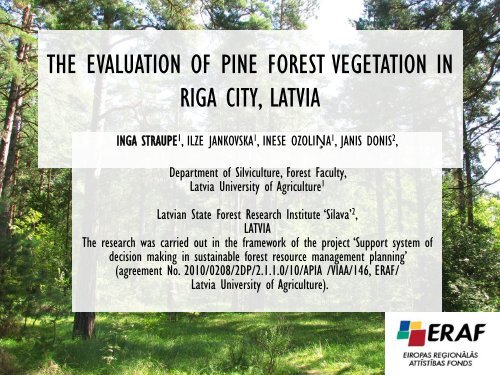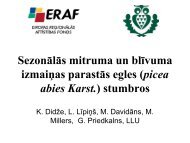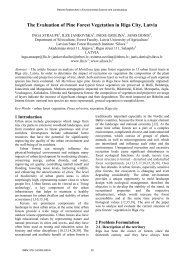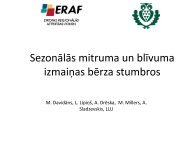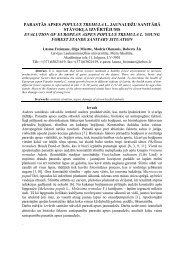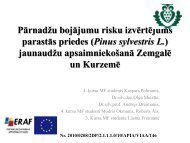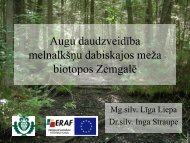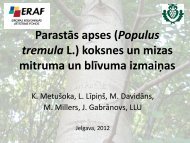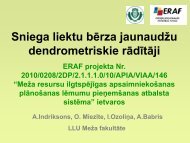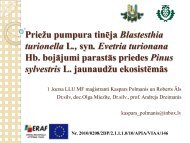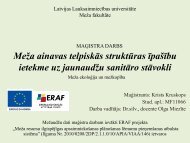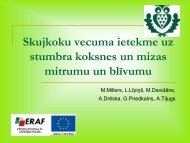The Evaluation of Pine Forest Vegetation in Riga City, Latvia - maplas
The Evaluation of Pine Forest Vegetation in Riga City, Latvia - maplas
The Evaluation of Pine Forest Vegetation in Riga City, Latvia - maplas
You also want an ePaper? Increase the reach of your titles
YUMPU automatically turns print PDFs into web optimized ePapers that Google loves.
THE EVALUATION OF PINE FOREST VEGETATION IN<br />
RIGA CITY, LATVIA<br />
INGA STRAUPE 1 , ILZE JANKOVSKA 1 , INESE OZOLIŅA 1 , JANIS DONIS 2 ,<br />
Department <strong>of</strong> Silviculture, <strong>Forest</strong> Faculty,<br />
<strong>Latvia</strong> University <strong>of</strong> Agriculture 1<br />
<strong>Latvia</strong>n State <strong>Forest</strong> Research Institute ‘Silava’ 2 ,<br />
LATVIA<br />
<strong>The</strong> research was carried out <strong>in</strong> the framework <strong>of</strong> the project ‘Support system <strong>of</strong><br />
decision mak<strong>in</strong>g <strong>in</strong> susta<strong>in</strong>able forest resource management plann<strong>in</strong>g’<br />
(agreement No. 2010/0208/2DP/2.1.1.0/10/APIA /VIAA/146, ERAF/<br />
<strong>Latvia</strong> University <strong>of</strong> Agriculture).
Urban forests<br />
Urban greenspaces <strong>in</strong>clude substantial forest resources which can strongly<br />
<strong>in</strong>fluence the biological environment and mitigate many impacts <strong>of</strong> urban<br />
development by<br />
‣ moderat<strong>in</strong>g climate,<br />
‣ conserv<strong>in</strong>g energy, carbon dioxide, and water,<br />
‣ improv<strong>in</strong>g air quality,<br />
‣ controll<strong>in</strong>g ra<strong>in</strong>fall run<strong>of</strong>f and flood<strong>in</strong>g,<br />
‣ lower<strong>in</strong>g noise levels,<br />
‣ harbor<strong>in</strong>g wildlife,<br />
‣ enhanc<strong>in</strong>g the attractiveness <strong>of</strong> cities<br />
Urban forests can<br />
be viewed as a key<br />
component <strong>of</strong> the<br />
urban <strong>in</strong>frastructure
Urban forests<br />
• are prom<strong>in</strong>ent components <strong>of</strong> the landscape <strong>in</strong> urban areas<br />
• they provide a wide range <strong>of</strong> recreational and outdoor leisure opportunities<br />
• have high educational values by represent<strong>in</strong>g nature and natural processes<br />
<strong>in</strong> cities and towns<br />
• used as test<strong>in</strong>g and education areas for forestry<br />
<strong>The</strong> recreational and aesthetic benefit is<br />
traditionally important especially <strong>in</strong> the Nordic and Baltic countries,<br />
because the forest is a major element <strong>of</strong> the<br />
landscape and national economy
Urban forests<br />
‣ Unorganized recreation and excessive recreation causes significant disturbances<br />
to forest ecological functions.<br />
As result, mosaic type forest structure is formed – disturbed and undisturbed<br />
forest compartments.<br />
<strong>The</strong> urban environment provides a unique opportunity to<br />
comb<strong>in</strong>e landscape design with ecological management
<strong>Latvia</strong><br />
‣ country <strong>in</strong> the Baltic region <strong>of</strong><br />
Northern Europe<br />
Territory - 64,589 km 2<br />
Inhabitants: 2,067,887<br />
‣ it is one <strong>of</strong> the least densely populated countries<br />
<strong>of</strong> the European Union<br />
‣ has a temperate seasonal climate
<strong>Riga</strong>, the capital <strong>of</strong> <strong>Latvia</strong><br />
‣ <strong>Riga</strong> is located along the Baltic Sea at the southern coast <strong>of</strong> the Gulf <strong>of</strong> <strong>Riga</strong><br />
<strong>Riga</strong> is situated on the<br />
banks <strong>of</strong> the Daugava<br />
River, about 10<br />
kilometers from where<br />
the Daugava flows <strong>in</strong>to<br />
the Gulf <strong>of</strong> <strong>Riga</strong><br />
<strong>The</strong> natural terra<strong>in</strong> <strong>of</strong> this area is a flat and sandy pla<strong>in</strong>,<br />
about 1 to 10 meters above the sea level
<strong>Riga</strong>, the capital <strong>of</strong> <strong>Latvia</strong><br />
‣ Climate is <strong>in</strong>fluenced by its<br />
proximity to the sea<br />
(moderately warm and humid)<br />
Summers - cool and cloudy<br />
W<strong>in</strong>ters - warm with frequent thaws
<strong>Riga</strong>, the capital <strong>of</strong> <strong>Latvia</strong><br />
<strong>The</strong> territory <strong>of</strong> <strong>Riga</strong> - 304.05 km 2 :<br />
29.9% Dwell<strong>in</strong>g space - 91.03 km 2<br />
2.3% Industrial space - 6.9 km 2<br />
2.9% Land for technological structures - 8.65 km 2<br />
14.9% Roads (streets) - 45.19km 2<br />
28.0% Green area - 85.09 km 2<br />
15.7% Water – 47.67km 2<br />
5.5% Port area – 16.66 km 2<br />
0.9% Airfield land – 2.86 km 2
<strong>Forest</strong>s <strong>in</strong> <strong>Riga</strong><br />
*0.8% <strong>of</strong> all <strong>Latvia</strong>’s forests are considered urban forests and 20% <strong>of</strong> urban areas covered by forests<br />
‣ <strong>Riga</strong> has been the owner <strong>of</strong><br />
forests s<strong>in</strong>ce the thirteenth<br />
century<br />
‣ Today municipality owns<br />
more than 55.600 ha<br />
<strong>of</strong> forests and <strong>in</strong> <strong>in</strong>ner<br />
city there are 4243.7<br />
ha <strong>of</strong> forests
<strong>Forest</strong>s <strong>in</strong> <strong>Riga</strong><br />
<strong>The</strong> dynamics <strong>of</strong> land use and<br />
management <strong>of</strong> green space <strong>in</strong> <strong>Riga</strong><br />
city are based on<br />
• the ma<strong>in</strong> laws <strong>in</strong> <strong>Latvia</strong><br />
• the numerous documents<br />
regulations <strong>of</strong> municipality<br />
‣ differences between ma<strong>in</strong>tenance and<br />
management <strong>of</strong> rural and urban forest is<br />
not specified by the legislation
‣ <strong>Riga</strong> city forests consist <strong>of</strong><br />
15 forest tracts which are<br />
connected with rural forests<br />
and some small, isolated<br />
forests – the remnants <strong>of</strong><br />
ancient forest or planted<br />
forests<br />
<strong>Forest</strong>s <strong>in</strong> <strong>Riga</strong>
<strong>Forest</strong>s <strong>in</strong> <strong>Riga</strong><br />
<strong>The</strong> aim <strong>of</strong> the research was to analyse and evaluate the<br />
current situation <strong>of</strong> p<strong>in</strong>e forests’ vegetation <strong>in</strong> <strong>Riga</strong> city<br />
<strong>The</strong> ma<strong>in</strong> tree species is Scots p<strong>in</strong>e P<strong>in</strong>us<br />
sylvestris L.<br />
(46.9 km 2 or 88% <strong>of</strong> total forest area)
Methods <strong>of</strong> vegetation research (1)<br />
•<strong>The</strong> research was carried out <strong>in</strong> Myrtillosa type p<strong>in</strong>e forests, which constitutes the highest<br />
proportion (33%) <strong>of</strong> the prevail<strong>in</strong>g forests on dry sites <strong>in</strong> <strong>Riga</strong> city<br />
•In each forest tract dur<strong>in</strong>g the vegetation season <strong>of</strong> 2011, 45 vegetation sample plots were<br />
arranged and surveyed (the area <strong>of</strong> each sample plot - 400 m2)<br />
•<strong>The</strong> age <strong>of</strong> p<strong>in</strong>e is 80-94 years<br />
•<strong>The</strong> Braun-Blanquet method was used to describe the plant communities: the total projective<br />
coverage <strong>of</strong> tree (E3), shrub (E2), herb (E1) and moss (E0) layer as well as the coverage <strong>of</strong><br />
each separate species was evaluated <strong>in</strong> the sample plots <strong>in</strong> percentage
Methods <strong>of</strong> vegetation research (2)<br />
•<strong>The</strong> descriptions <strong>of</strong> vegetation were summarised <strong>in</strong> the data base <strong>of</strong> the Excel s<strong>of</strong>tware<br />
programme<br />
•<strong>The</strong> occurrence <strong>of</strong> plant species is characterised by the constancy class which is calculated by<br />
referr<strong>in</strong>g the number <strong>of</strong> those sample plots where the species has been identified to the<br />
number <strong>of</strong> the whole group <strong>of</strong> sample plots:<br />
I - < 21, II - 21-40, III - 41-60, IV - 61-80, V - 81-100 %<br />
•Data process<strong>in</strong>g was carried out with the s<strong>of</strong>tware programme Community analysis package<br />
(Pisces Conservation Ltd.) TWINSPAN and PCA (Pr<strong>in</strong>cipal component analysis)<br />
• For the credibility evaluation statistical methods were used
<strong>The</strong> number <strong>of</strong> species<br />
In <strong>Riga</strong> urban p<strong>in</strong>e forests <strong>in</strong><br />
total:<br />
‣ 154 vascular plant species<br />
‣ 18 moss species<br />
18<br />
44<br />
tree and shrub species<br />
herbaceous species<br />
110<br />
moss species<br />
142<br />
10<br />
37<br />
tree layer<br />
shrub layer<br />
herb layer
<strong>The</strong> number <strong>of</strong> species
<strong>The</strong> coefficient <strong>of</strong> occurrence and constancy class<br />
<strong>The</strong> coefficient <strong>of</strong> occurrence and constancy class show how stable a<br />
species is <strong>in</strong> a particular habitat: the higher constancy class, the more<br />
stable position the species occupies <strong>in</strong> the plant community<br />
‣ <strong>The</strong> researched plots are located <strong>in</strong> anthropogenically impacted forests,<br />
therefore the tendency <strong>of</strong> species <strong>in</strong>constancy has been observed
<strong>The</strong> occurrence <strong>of</strong> species (constancy)<br />
<strong>The</strong> most <strong>of</strong>ten (constancy class V) found<br />
tree species is<br />
P<strong>in</strong>us sylvestris and shrub species are<br />
Sorbus aucuparia and Amelanchier spicata<br />
<strong>The</strong>re are neither herbaceous plant nor moss species <strong>in</strong> this class<br />
Photo-N.Prieditis
<strong>The</strong> occurrence <strong>of</strong> species (constancy)<br />
In the constancy class IV Quercus robur,<br />
Acer platanoides and Frangula alnus <strong>in</strong><br />
the shrub layer...<br />
Photo-N.Prieditis
<strong>Riga</strong>, the capital <strong>of</strong> <strong>Latvia</strong><br />
<strong>The</strong> occurrence <strong>of</strong> species (constancy)<br />
...and herbaceous species Luzula pilosa,<br />
Lerchenfeldia flexuosa, Fragaria vesca,<br />
Rubus idaeus are observed.<br />
Photo-N.Prieditis
<strong>The</strong> occurrence <strong>of</strong> species (constancy)<br />
<strong>The</strong> results obta<strong>in</strong>ed show that <strong>in</strong> forest ecosystem the layers <strong>of</strong> herbs<br />
and mosses respond most sensitively to different unfavourable<br />
disturbances<br />
Low level <strong>of</strong> constancy may be <strong>in</strong>dicative <strong>of</strong> two reasons:<br />
‣ the species has just been established and will be<br />
developed <strong>in</strong> the future<br />
‣ it will be suppressed by other species and cast out<br />
<strong>of</strong> the plant community
<strong>The</strong> occurrence <strong>of</strong> species (constancy)<br />
In the p<strong>in</strong>e forests the species with low constancy are typical<br />
meadow species<br />
It should be taken <strong>in</strong>to account that after the<br />
disturbance succession starts <strong>in</strong> the forest.<br />
As a result <strong>of</strong> that the plant communities which are<br />
similar to the previous vegetation are restored.<br />
<strong>The</strong>refore long-term monitor<strong>in</strong>g is required to precisely<br />
characterise the conditions <strong>of</strong> forest vegetation.
<strong>The</strong> occurrence <strong>of</strong> species (constancy)<br />
<strong>The</strong> p<strong>in</strong>e and spruce forest species are<br />
the most commonly found<br />
Photo-N.Prieditis
<strong>The</strong> occurrence <strong>of</strong> species (constancy)<br />
‣ <strong>The</strong> species <strong>in</strong>troduced <strong>in</strong> <strong>Latvia</strong> such as Amelanchier<br />
spicata, as well as adventive species Impatiens<br />
parviflora have been naturalized <strong>in</strong> urban forests<br />
Photo-N.Prieditis
<strong>The</strong> occurrence <strong>of</strong> species (constancy)<br />
‣ <strong>The</strong> species Chamaenerion angustifolium, Fragaria vesca<br />
and Rubus idaeus are rapidly develop<strong>in</strong>g after<br />
anthropogenic disturbances, which are connected with the<br />
improvement <strong>of</strong> light conditions and more rapid<br />
decomposition <strong>of</strong> nutrients <strong>in</strong> such places<br />
Photo-N.Prieditis
<strong>The</strong> comparision <strong>of</strong> projective coverage (%) <strong>of</strong> tree layer and<br />
P<strong>in</strong>us sylvestris
<strong>The</strong> projective coverage <strong>of</strong> layers Myrtillosa<br />
type p<strong>in</strong>e forests <strong>in</strong> <strong>Riga</strong>
<strong>The</strong> projective coverage <strong>of</strong> layers<br />
‣ In several forest tracts the shrub layer is very dense: it can been seen that fruitification has<br />
taken place.<br />
‣ It shows gradual expansion <strong>of</strong> shrub communities and deciduous forests <strong>in</strong> the territory <strong>of</strong><br />
<strong>Latvia</strong>, which is connected with climate changes and enrichment <strong>of</strong> the environment with<br />
nutrients, especially with nitrogen.
<strong>The</strong> projective coverage <strong>of</strong> layers<br />
‣ A dense undergrowth h<strong>in</strong>ders not only forest regeneration, but it also makes the forest<br />
stands uniform, out <strong>of</strong> full vision, impenetrable and unsuitable for recreation.<br />
‣ In these places it is advisable to carry out such activities as th<strong>in</strong>n<strong>in</strong>gs and partial<br />
cutt<strong>in</strong>g <strong>of</strong> undergrowth to improve the landscape.
<strong>The</strong> functional groups <strong>of</strong> plants<br />
<strong>The</strong> distribution <strong>of</strong> herb layer species <strong>in</strong><br />
funcional groups
<strong>The</strong> functional groups <strong>of</strong> plants<br />
17 8 boreal species<br />
40<br />
37<br />
31<br />
meadow species<br />
nemoral species<br />
nitrophytic species<br />
hygrophytic species
<strong>The</strong> moss layer<br />
‣ In the moss layer 18 species are found<br />
‣ most species-<br />
Dicranum polysetum,<br />
Dicranum scoparium,<br />
Hylocomium splendens,<br />
Plagiomnium aff<strong>in</strong>e,<br />
Plagiomnium undulatum,<br />
Pleurozium schreberi,<br />
Polytrichum juniper<strong>in</strong>um,<br />
Ptilium crista-castrensis,<br />
Rhytidiadelphus squarrosus<br />
Rhytidiadelphus triquetrus<br />
are characterized by poor sand soils <strong>in</strong> coniferous and coniferousdeciduous<br />
forests
Antropogenic impact on vegetation
<strong>The</strong> further research<br />
‣ <strong>The</strong> further research <strong>of</strong> forest vegetation needs to be done, modell<strong>in</strong>g the distribution<br />
<strong>of</strong> visitors <strong>in</strong> forest tracts for different distances by us<strong>in</strong>g <strong>of</strong> GIS technique.<br />
‣ It would be potential to <strong>in</strong>terpret results <strong>of</strong> forests’ ecological and social functions as<br />
well as to develop more advanced management <strong>of</strong> urban forests.
Thank you for attention!<br />
<strong>The</strong> research was carried out <strong>in</strong> the framework <strong>of</strong> the project ‘Support system <strong>of</strong><br />
decision mak<strong>in</strong>g <strong>in</strong> susta<strong>in</strong>able forest resource management plann<strong>in</strong>g’<br />
(agreement No. 2010/0208/2DP/2.1.1.0/10/APIA /VIAA/146, ERAF/<br />
<strong>Latvia</strong> University <strong>of</strong> Agriculture).


